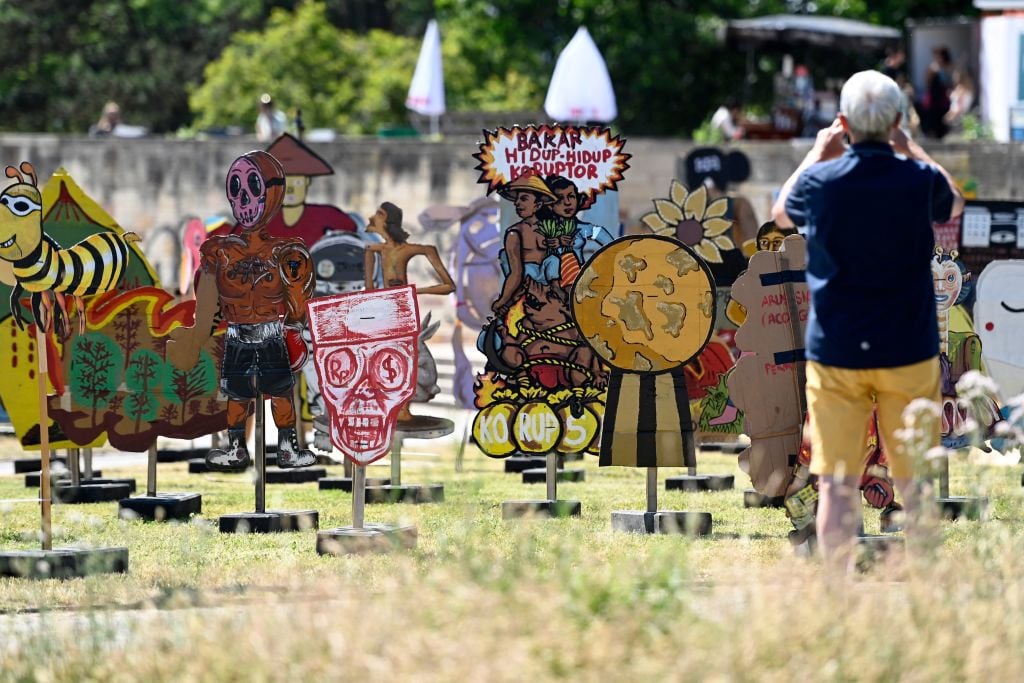
Citing antisemitism, a large publicly installed artwork by the Indonesian collective Taring Padi has been covered up by the artists and the organizers of this year’s Documenta 15.
The work in question, titled People’s Justice, consists of a large banner meant to commemorate victims of Indonesia’s long and brutal dictatorship under former General Suharto, who controlled the nation from 1967 to 1998. The work, which features many exaggerated satirical characters, was made in 2002.
One of the caricatures depicted, however, seems to be a member of the Mossad, Israel’s secret service, depicted as a pig. Another figure with fangs and blood-red eyes appears to be an Orthodox Jewish man wearing a black hat with “SS,” the acronym for the Nazi Schutzstaffel.
The discovery of these characters within the work erupted into a massive controversy yesterday, June 21, just days after the quinquennial’s official opening on June 18. By the end of the day, the artwork was covered up. The collective is being accused of antisemitism by German media as well Israel’s embassy to Germany—the latter voiced “disgust” in Times of Israel over the artwork’s inclusion in the world-renowned exhibition.
Taring Padi issued an apology for the controversy the work has caused, stating it was not their intention for the figures to be seen in an antisemitic light.
Detail of the mural People’s Justice by the Indonesian artist group Taring Padi. In the center of the artwork, one can see a figure that appears to be an Orthodox Jew with an “SS” on his hat, as well as a pig wearing a helmet with “Mossad” written on it. (Photo by Thomas Lohnes/Getty Images)
“It is not meant to be related in any way to antisemitism,” the collective said in a statement published yesterday evening on Documenta’s official website. They said that they often depict soldiers as animals as a criticism of capitalism and military violence.
“We are saddened that details in this banner are understood differently from its original purpose. We apologize for the hurt caused in this context,” they added. The collective’s announced “with great regret” that the work would should be immediately covered up.
“This work then becomes a monument of mourning for the impossibility of dialogue at this moment,” they said. “This monument, we hope, will be the starting point for a new dialogue.”
The apology does not seem to be enough. Some in Germany are calling for the group and organizers to be prosecuted. The president of the German-Israel Society, Volker Beck, told the German conservative tabloid Bild that he intended to file a case with prosecutors over the artwork, citing the fact that antisemitism is a crime in Germany.
Israel’s embassy called out the exhibition as well, saying in a press statement issued on its Twitter on Monday that “Documenta promotes Goebbels-style propaganda.”
“Not only have all the red lines been crossed, they have been smashed,” it added.
Minister of State for Culture Claudia Roth said the “mere” covering up of the work and apology is unacceptable. “The removal of this mural is only a first step. It must now be followed by others: It must be clarified how it could come about that this mural with anti-Semitic pictorial elements was installed there in the first place,” she said.
Artnet News reached out to both Taring Padi and Documenta for further comment but have yet to hear a response.
The concealing of the artwork at Friedrichsplatz is the latest in an ongoing controversy surrounding this year’s Documenta, which had already been facing allegations of antisemitism. The curators of Documenta 15, Ruangrupa, cancelled a panel around the topic, which was set to take place in April, after it faces claims that the talks were biased.
The German media has called into question the lack of Israeli artists in the show, which is focused on non-Western art. Many have questioned whether it is tenable that a few participants and artistic team members allegedly support the pro-Palestinian Boycott, Divestment, and Sanctions (BDS) movement.
For their part, Ruangrupa’s members have vehemently denied any allegations of antisemitism, calling them “racist defamations.”
In May, vandals attacked the arts venue in Kassel that is hosting a Palestinian group show with graffiti, spurring more debate in Germany as to where the boundaries between hate speech and artistic freedom of expression.
Installation by the group The Question of Funding at WH22. The graffiti “187,” which may be a reference to a U.S. penal code, was interpreted by some to be a threat to the Palestinian collective showing there. It was not removed for the exhibition. Photo by Ben Davis.
“We denounce the media participation in these smear campaigns,” Ruangrupa said in a statement. “We also express our dismay and disappointment at the amplification that the original baseless blog post of disinformation and manipulated content received in some of the mainstream media.”
The general director of Documenta and Museum Fridericianum Sabine Schormann emphasized that the institution cannot be expected to do background checks on artworks. “The Documenta management is not, and should not be, an authority to which artistic exhibits must be submitted for inspection in advance,” she said. “The banner was installed at Friedrichsplatz last Friday afternoon after necessary restoration work was carried out on the 20-year-old work due to storage damage.”
Schormann pointed out that the work was not conceived for Kassel or Documenta 15. “It was created in the context of Indonesia’s political protest movement and was shown there, and in other non-European locations,” she said. “All parties involved regret that feelings were hurt in this way.” She said the organization is going to bring together an external advisory on the matter.
Founded by Arnold Bode, Documenta runs with a public budget of €42 million ($51 million), making it one of the largest exhibitions of art in the world. Documenta 15 became the largest show yet with over 1,500 artists participating.